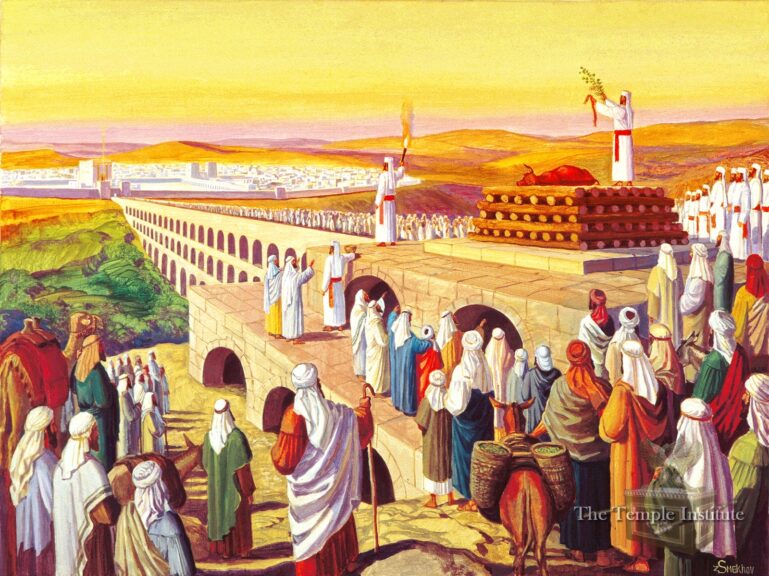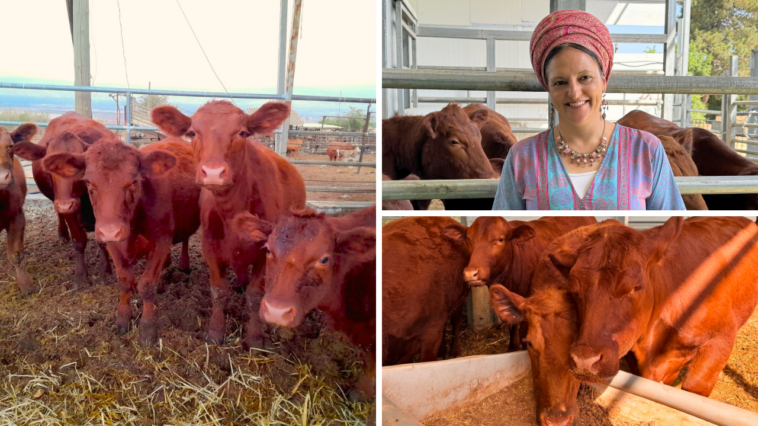ANCIENT SHILOH, ISRAEL—Twenty miles north of Jerusalem, five Texas Red Angus cows chew on grass, oblivious to the fact that their mere presence in Israel was cited by Hamas as a reason for its massacre of Israeli civilians on October 7. The terror organization’s spokesperson says the cows were a justification for the attack, stating that bringing them to Israel was “an aggression” based on a “detestable religious myth.”
In Ancient Shiloh, located in Samaria, also referred to as the West Bank, Moriyah Shapira proudly showcases the red heifers, which were brought to Israel after a long, tedious search. The animals comply with a very specific set of characteristics outlined in verses in the Book of Numbers in the Old Testament.
The Hebrew Bible states that red heifers are necessary for a purification ceremony to enter the Temple or its portable predecessor, the Tabernacle. Moses performed a ceremony with red heifer ashes that were used for the Tabernacle in the Sinai before the Jews entered Israel after his death.
Hamas has called the importation of the red cows an act of “aggression” because it falsely believes that the presence of the cows may ignite the rebuilding of the Temple, which the group thinks would end Arab control of the Temple Mount, where the Al-Aqsa Mosque is located.
But rabbis say the return of the red cows does not mean the Temple will be rebuilt anytime soon. Shapira says bringing the cows to Israel, and specifically to Shiloh, is an “amazing thing” because it’s the last place the Tabernacle stood before King Solomon built the Temple in Jerusalem, according to the Bible.
“We’re here where the Tabernacle stood for the first time — for 369 years in the first capital city of Israel,” said Shapira, who is the Chief Content Officer of Ancient Shiloh. “We brought here the five red heifers from Texas. It’s an amazing thing and people are coming from all over to see them.”
Shapira’s role with Ancient Shiloh includes educating the thousands of guests who visit each year to see the archaeological site of the Tabernacle. Visitors are able to immerse themselves in the setting of several Biblical stories, including Joshua dividing the tribes of Israel and Hannah praying for a child.
While there is much uproar over what bringing five red cows to Israel means, Shapira says the plan is to open an educational visitor center in Shiloh where people can visit them.

WEST BANK – SEPTEMBER 09: A Star of David mosaic is embedded on an ancient floor inside an old structure, close to the Tabernacle site at the Jewish village of Shiloh on Sept. 9, 2008. (Photo by Ahikam Seri/Bloomberg via Getty Images)
“The idea is that we’ll have people here from all over to see Shiloh… and to learn about the subject of red heifers, which is very spiritual and interesting and amazing,” she said. “They will enter the visitor center, and then they’ll see a movie, and the screen will go up, and from a window, they’ll see the red heifers.”
Shapira shut down conspiracies spread on social media about plans to kill the red heifers for a ceremony this year.
“There are no specific plans when to make the ceremony of the red heifers,” she said. “That is something very important so it needs to be agreed on first of all, among rabbis and Israelis, the people of Israel, and then among the nations. We want it to be agreeable and in a peaceful way so it will bring a blessing to the world.”
How the Cows Made It To Israel
The red heifers were purchased from a Christian rancher who began raising the Red Angus breed 30 years ago in the hopes of fulfilling Biblical prophecy, according to Shapira.

The red heifers, who now live in Israel, as calves. (Photo: Courtesy)
As calves, the cows were brought as pets with special government permission to avoid the restriction against importing livestock. Shapira says it cost $500,000 to bring them here, and that that cost as well as the cost of caring for the cows and building a visitor center is fueled by donations.
Upon arrival, the cows were in an undisclosed location until making their way to Ancient Shiloh, where they are now well-guarded due to threats against their lives.
Their names are Segula (Protection), Geula (Redemption), Tikva (Hope), Nechama (Comfort), and Techiya (Rebirth).
The heifers need to fit the exact physical conditions outlined in the Hebrew Bible—including having every single hair on their body the perfect color. Three of the cows so far have been disqualified because a few hairs are not red. Shapira says they plan to breed the disqualified cows to create a larger herd in Israel.
Who Supports A Red Heifer Ceremony
Conducting a red heifer ceremony is controversial in rabbinic circles, and there is far from a consensus over whether it can even be done, according to the Temple Institute, which provides rabbinical supervision for the cows.
“There is no plan right now for using a kosher red heifer, killing it and turning it into ashes,” Yitzchak Reuven, the director of international development for the Temple Institute told The Daily Wire. “Anyone saying this is making it up. We will only do this when the time is right, because there is no point in doing it if the Jewish and rabbinic world won’t accept it.”
He added that even with the ashes, the Temple may not be “built for hundreds of years, as was the case concerning the first Temple.”
Instead, Reuven said his Institute has spent 20 years educating and dedicating resources to ensure that the “mitzvah,” the Hebrew word for commandment, can be done properly when the day comes. The Institute says it has also been exploring the other necessary steps, including finding a kosher kohen (a person from the priestly tribe who has never been around a dead body, in a hospital, or in a cemetery), obtaining cedar wood hyssop and red-dyed wool, and investigating which wood would yield the most ashes.
“The Temple Institute is involved in trying to educate people about the Temple, and recreated the vessels so they are ready when the day comes,” he said. “This shows people that they aren’t magical mystical things. There’s nothing magical or mystical about the red heifer.”
Reuven emphasized that the Jewish religion does not believe a red heifer being in Israel means that the messiah necessarily has arrived or that having one will force the messiah to arrive.
“There is tremendous interest in the Christian world because they see it as part of the prophecy and will lead to the return of Jesus,” Reuven said, adding that there are hundreds of thousands of red heifer candidates in the world, citing the Red Angus and the Highland Cattle in Scotland.
Only nine red heifers have ever been slaughtered and burned to create ashes needed for purification since the time of Moses, according to the prolific Torah scholar Maimonides. Reuven explained that ashes from one heifer can work for large amounts of purifications, and compared the method to sourdough, where you can continue to add more water to the mixture to keep it plentiful.
“We do not want to ignite World War III,” Reuven said. “It’s a mitzvah in the Torah and we want to be able to fulfill it and it shouldn’t be seen as a threat to anyone. People should calm down a bit because we’re talking about a heifer and a ceremony that is 4,000 years old.”
Reuven called out a CBS News report that falsely claimed a white altar was awaiting the ceremony.

A depiction of the Red Heifer ceremony. (Photo: The Temple Institute)
“First, the red heifer ceremony doesn’t use an altar and the one in the West Bank is not kosher, and is only for educational purposes,” Reuven said.
Reuven said there are possible plans in the works to do a practice run of the ceremony without a heifer, though he was unable to provide more details.
While most offerings outlined in the Bible are to be eaten by priests and others, the red heifer is to be burnt completely to ash.
In response to animal lovers concerned about the ceremony, Reuven said he respects the views of vegetarians and vegans who oppose killing an animal for religious purposes.
“Anyone who feels that it is inhumane to kill an animal, I respect that,” he said. “It’s a Torah commandment which is why we are pursuing it. In today’s world, the industrial slaughter of animals is very inhumane, but everyone who eats meat is engaging in it.”
The Response From Hamas
Reuven took note that Hamas claimed the red heifers were a motivation for its October 7 massacre of Israelis.
“Until recently I don’t think the Muslim world took much interest in it, but after October 7 Hamas called their massacre the Al-Aqsa flood, they added that the preparation for the red heifer is one of their motivating factors,” he said. “I don’t think they need any motivation to slaughter Jews, but they’re piggybacking on the red heifer in order to raise the volume.”
Despite Hamas’ rhetoric and criticism from other religions, the red heifer is not the key to begin rebuilding the Temple, according to Reuven.
“Not having the ashes doesn’t really prevent us from getting started building the Temple or bringing offerings that don’t require purification, like the Passover offering,” he said. “The main thing we need to build a Temple is that the Jewish people want to build a Temple. I don’t endorse the scenario that there will be a big war and then we will build a Temple. It’s supposed to be a peaceful place and will be done peacefully, and a place for prayer for all nations and we will need a consensus of the major religions.”
Shapira also said that, if the Temple were to be rebuilt, it would need to come about in a peaceful way and be a place of worship for all faiths, as it was in ancient Israel.
“We know that the Temple will bring light to the world, and the people from all the nations will come, and it’s called the House of Prayer for all nations,” she said. “So this is the hope that when the Temple will be in its place, that it will bring peace to the Muslims, so that everybody would enjoy the light and the presence of God in the place which would be like it was 2,000 years ago.”
Shapira added that, if the time came, it could not be done violently.
“We’re people of peace,” Shapira said. “We want only good, we’re not going to do anything in a violent way. We want to be ready when God decides it’s the right time, and the Temple will bring blessings to all of the world, including the Muslims.”
“One hundred years ago, nobody believed that the people of Israel would come back to their land after so many years of exile, and we would build here the state of Israel, and it just happened,” she said. “Same thing about the red heifers in the Temple. We’re not gonna do anything by force, but we’re getting ready on our side, and it will just happen when it’s the right time.”



